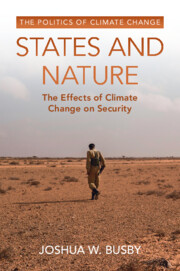Book contents
- States and Nature
- The Politics of Climate Change
- States and Nature
- Copyright page
- Dedication
- Contents
- Figures
- Maps
- Tables
- Acknowledgments
- 1 Introduction
- 2 Conceptualizing Climate and Security
- 3 The Argument, Method, and Mechanisms
- 4 Droughts and Famine in Somalia and Ethiopia
- 5 Drought in the Middle East
- 6 Cyclones in South Asia
- 7 Beyond Internal Conflict
- 8 The Next Decade of Climate Security Research
- 9 Conclusion
- Bibliography
- Index
3 - The Argument, Method, and Mechanisms
State Capacity, Institutional Inclusion, and International Assistance
Published online by Cambridge University Press: 03 March 2022
- States and Nature
- The Politics of Climate Change
- States and Nature
- Copyright page
- Dedication
- Contents
- Figures
- Maps
- Tables
- Acknowledgments
- 1 Introduction
- 2 Conceptualizing Climate and Security
- 3 The Argument, Method, and Mechanisms
- 4 Droughts and Famine in Somalia and Ethiopia
- 5 Drought in the Middle East
- 6 Cyclones in South Asia
- 7 Beyond Internal Conflict
- 8 The Next Decade of Climate Security Research
- 9 Conclusion
- Bibliography
- Index
Summary
This chapter reviews the argument in the book to understand the intersection between state capacity, political exclusion, and international assistance and how these conjoin to contribute to negative security outcomes. I discuss how to operationalize each of these parameters. I then diagram several causal pathways connecting these factors to negative security outcomes. I also develop predictions for likely outcomes when these factors have more favorable and mixed characteristics in terms of state capacity, exclusion, and assistance.
- Type
- Chapter
- Information
- States and NatureThe Effects of Climate Change on Security, pp. 37 - 70Publisher: Cambridge University PressPrint publication year: 2022

